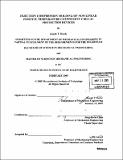| dc.contributor.advisor | Jung-Hoon Chun. | en_US |
| dc.contributor.author | Hardy, Joseph T., 1978- | en_US |
| dc.contributor.other | Massachusetts Institute of Technology. Dept. of Mechanical Engineering. | en_US |
| dc.date.accessioned | 2006-03-24T18:39:23Z | |
| dc.date.available | 2006-03-24T18:39:23Z | |
| dc.date.copyright | 2005 | en_US |
| dc.date.issued | 2005 | en_US |
| dc.identifier.uri | http://hdl.handle.net/1721.1/30315 | |
| dc.description | Thesis (S.M. and S.B.)--Massachusetts Institute of Technology, Dept. of Mechanical Engineering, 2005. | en_US |
| dc.description | Includes bibliographical references (leaf 72). | en_US |
| dc.description.abstract | Polymeric self-resettable circuit protection devices have been manufactured for many years with an extrusion based process. These devices add negligible resistance to a circuit at normal power operating conditions but increases in resistance by several orders of magnitude at a pre-determined level of power in order to protect the circuit from over- current or over-voltage conditions. After the electrical surge stops, and power returns to a normal level, the resistance of the device drops, and the circuit may resume its normal operation. These devices are used in computers, cell-phones, and other consumer and industrial electronic devices where normal fuses are not convenient or practical. The current manufacturing process extrudes long sheets of 2-mm thick polymer lined with 0.05-mm thick foil on both sides. This foil-polymer-foil structure, called plaque, is punched into 13 mm x 8 mm x 2 mm rectangles, called chips. The chips undergo heat treatment and radioactive cross-linking steps before wire leads are soldered onto them for easy electrical connection to either test or circuit boards. Though effective, this process produces more waste and remains less flexible than an injection-compression (IC) molding process. With this new process, devices are made individually in a multi- cavity mold, skipping the punching and soldering steps. This thesis explores IC molding and its benefits and drawbacks for manufacturing circuit protection devices. IC molded devices were manufactured, tested, and compared to standard devices, produced by the extrusion process, in the areas of physical and electrical performance. | en_US |
| dc.description.abstract | (cont.) Budget considerations prevented the study of individually IC molded devices and instead a 150 mm x 75 mm mold cavity was used to create an IC molded plaque from which chips could be punched and wire leads attached. In this way, any electrical variations across the IC molded plaque, produced by flow or thermal properties of the new process, could be studied with electrical tests, and physical variations across the IC molded plaque could be examined with a peel test. Cycle life data and data comparing device resistance to device temperature show that the new manufacturing process has potential to create equal or better performing devices than the existing extrusion process. | en_US |
| dc.description.statementofresponsibility | by Joseph T. Hardy. | en_US |
| dc.format.extent | 72 leaves | en_US |
| dc.format.extent | 4036969 bytes | |
| dc.format.extent | 4044270 bytes | |
| dc.format.mimetype | application/pdf | |
| dc.format.mimetype | application/pdf | |
| dc.language.iso | eng | en_US |
| dc.publisher | Massachusetts Institute of Technology | en_US |
| dc.rights | M.I.T. theses are protected by copyright. They may be viewed from this source for any purpose, but reproduction or distribution in any format is prohibited without written permission. See provided URL for inquiries about permission. | en_US |
| dc.rights.uri | http://dspace.mit.edu/handle/1721.1/7582 | |
| dc.subject | Mechanical Engineering. | en_US |
| dc.title | Injection compression modeling of non-linear positive temperature coefficient circuit protection devices | en_US |
| dc.type | Thesis | en_US |
| dc.description.degree | S.M.and S.B. | en_US |
| dc.contributor.department | Massachusetts Institute of Technology. Department of Mechanical Engineering | |
| dc.identifier.oclc | 61102933 | en_US |
